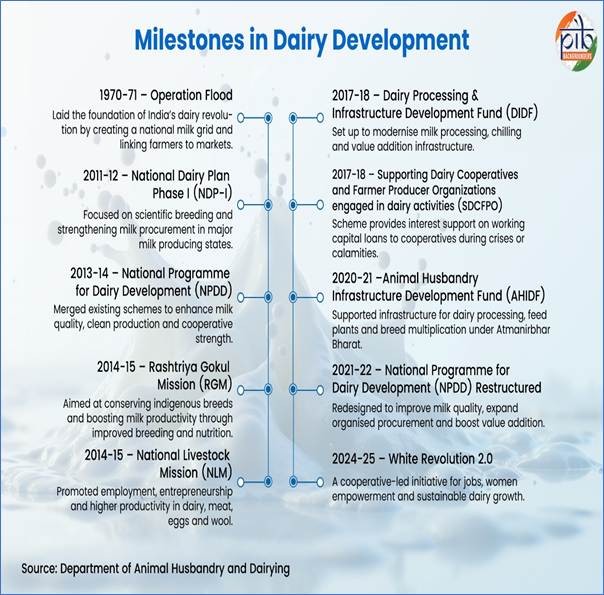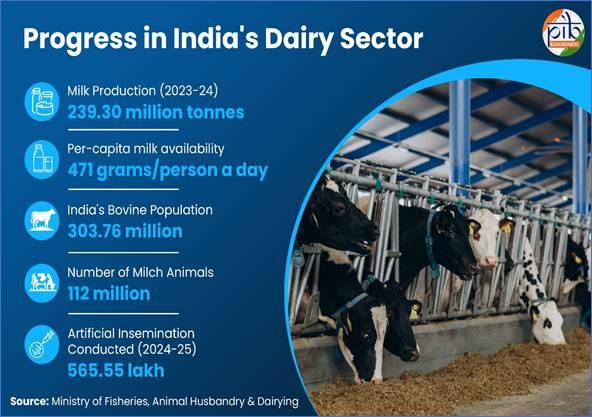



India’s dairy sector, anchored by initiatives like Operation Flood, Rashtriya Gokul Mission, NAIP, and White Revolution 2.0, has transformed the country into the world’s largest milk producer. It supports over 80 million farmers, empowers women through cooperatives, ensures nutritional security, and drives rural livelihoods. Ongoing reforms in infrastructure, breeding, sustainability, and GST rationalization aim to enhance productivity, promote inclusive growth, and strengthen India’s global competitiveness in dairy.

Copyright infringement not intended
Picture Courtesy: PIB
National Milk Day, observed on 26th November, marks the birth anniversary of Dr. Verghese Kurien, the “Father of the White Revolution,” honouring millions of farmers whose dedication sustains India’s leadership in milk production.
The White Revolution refers to the rapid and large-scale development of India’s dairy sector, transforming the country from a milk-deficient nation into the world’s largest milk producer. It is called the “White Revolution” because it mirrors the “Green Revolution” in agriculture, but focuses specifically on milk and dairy products, the white-coloured symbol of nutrition and livelihood.
Pre-Independence and Early Post-Independence Era (Before 1965)
Birth of Modern Dairy Movement (1960s–1970)
Operation Flood and the White Revolution (1970–1990s)
Expansion and Consolidation (1990s–2010)
Recent Developments and Modernization (2010–Present)

Picture Courtesy: PIB
Pillar of rural livelihoods: The dairy industry forms a critical support system for rural India, contributing over 6% of the national GDP and providing livelihoods to more than 80 million farmers. It accounts for 12–14% of agricultural income, making it a stable source of revenue for households across the country.
Ensuring nutrition for all: With a per-capita milk availability of 471 grams per day, India surpasses the global average of 322 grams. Milk delivers high-quality protein, calcium, and Vitamin B12, playing a vital role in combating malnutrition, anaemia, and stunting, particularly among children and vulnerable populations.
Driving women’s participation: Women are central to India’s dairy ecosystem, forming around 35% of cooperative members and leading 48,000 women-run societies. Their engagement not only boosts household income but also promotes inclusive growth, economic empowerment, and rural development.
Strengthening integrated farming: India’s vast livestock population, including 303.76 million bovines and 74.26 million goats, supports integrated agriculture by providing organic manure for crops and biogas for energy. This creates a synergistic system that enhances soil fertility, reduces energy costs, and strengthens farm sustainability.
Promoting sustainability and climate action: Initiatives such as the Gobar-Dhan scheme enable farmers to convert animal waste and crop residues into bio-CNG and organic fertilizers, creating new income streams.
Empowering small and marginal Farmers: Dairy farming provides a steady source of income for small and marginal farmers, often supplementing crop income. Programs like Operation Flood and NPDD connect farmers to organized markets, ensuring fair prices and reducing exploitation by middlemen.
Promoting Women’s Economic Participation: Women constitute about 70% of the dairy workforce and lead thousands of women-run cooperatives and milk producer organizations whereas schemes like White Revolution 2.0 and Rashtriya Gokul Mission prioritize women’s enrollment, training, and decision-making, boosting gender equity and household welfare.
Inclusive Rural Employment: Dairy cooperatives create local jobs in milk collection, processing, transportation, and veterinary services, especially in areas with limited industrial opportunities.
Bridging Regional Disparities: Dairy development programs focus on milk-deficient and backward regions, integrating them into the national dairy economy.
Low productivity of indigenous breeds: India’s cattle population is the largest in the world, but productivity per animal is significantly below the global average. Indigenous breeds often yield 2–3 liters/day, compared to crossbred cows producing 8–10 liters/day. As per NDDB data, bovine productivity grew by 27.39% between 2014–2022, but 70% of breedable animals still rely on scrub bulls with unknown genetic merit, limiting long-term productivity gains.
Inadequate access to veterinary and breeding services: Rural and remote areas often lack timely veterinary care, AI services, and reproductive technologies. In Bihar’s Gaya district, farmers reported calf mortality rates of 15–20% due to delayed vaccination and poor AI services.
Feed and Fodder Scarcity: Availability and quality of green fodder and concentrated feed remain major constraints. Seasonal variations, land scarcity, and climate change affect feed security. In Rajasthan and Haryana, prolonged heatwaves and droughts in 2022 reduced fodder availability, resulting in a drop in milk yields by 15–20%.
Fragmented and unorganized supply chains: cooperatives dominate organized dairying, unorganized markets still handle 40–50% of milk, leading to inefficiencies.
Climate change and environmental Stress: Rising temperatures, erratic rainfall, and water scarcity threaten dairy production. Heat stress reduces feed intake, milk yield, and fertility. Research by the Indian Council of Agricultural Research (ICAR) shows that temperature above 30°C can reduce milk yield in cows by 10–20%.
|
Initiative |
Year |
Objectives |
Key Impacts |
|
Operation Flood |
1970–1990s |
Increase milk production, develop cooperatives, link rural producers to urban markets |
India became the world’s largest milk producer; empowered millions of rural farmers and women |
|
National Dairy Development Board (NDDB) |
1965 onward |
Replicate Anand cooperative model nationally; strengthen cooperatives and infrastructure |
Organized village-level milk societies; technical and financial support to cooperatives; recognized as Institution of National Importance |
|
Rashtriya Gokul Mission (RGM) |
2014; revised 2025 |
Conserve indigenous breeds, improve genetic quality, enhance productivity |
Over 92 million animals and 56 million farmers benefited; ensured genetic diversity and sustainable milk production |
|
National Artificial Insemination Programme (NAIP) |
2014 onward |
Expand AI services, increase scientific breeding, provide doorstep veterinary support |
Covered 9.16 crore animals; 14.12 crore inseminations; increased female calf births; improved productivity |
|
National Programme for Dairy Development (NPDD) |
2014–2026 |
Enhance milk quality, expand organized procurement, strengthen cooperatives |
31,908 cooperatives formed/revived; 1.72 crore farmers connected; bulk milk coolers, testing labs, processing units established |
|
White Revolution 2.0 |
2024–2029 |
Modernize cooperatives, expand employment, increase milk procurement, empower women |
Target milk procurement: 1,007 lakh kg/day; 75,000 new cooperatives; Multi-State Cooperative Societies for feed, biofertilizers, and waste management |
|
Gobar-Dhan Scheme |
2018 onward |
Convert cattle dung and agri-waste into bio-CNG and organic fertilizers |
Additional revenue for farmers; promotes clean energy, waste-to-wealth practices, and rural entrepreneurship |
|
GST Reforms for Dairy Products |
2025 |
Reduce tax burden on milk and milk products |
Lowered operational costs; enhanced competitiveness; benefits 8 crore rural households |
|
Livestock Health & Disease Control Programs |
Ongoing |
Improve animal health, reduce disease-related losses |
Large-scale vaccination against FMD and Brucellosis; healthier herds; higher milk yields |
|
Infrastructure & Cooperative Development |
Ongoing |
Expand milk processing, chilling, and quality testing infrastructure |
Establishment of plants like Sabar Dairy; empowered women-led cooperatives; enhanced rural incomes and cooperative efficiency |
Enhance Productivity and Breed Improvement: Expand scientific breeding programs using AI, sex-sorted semen, and progeny-tested bulls. Focus on improving indigenous breeds while maintaining genetic diversity.
Strengthen Feed and Fodder Security: Promote year-round fodder cultivation and silage production. Encourage nutrient-rich and locally available feed resources to reduce dependence on expensive commercial feeds.
Expand Veterinary and Health Services: Ensure comprehensive vaccination coverage against diseases like FMD and Brucellosis. Strengthen rural veterinary outreach through mobile clinics and trained technicians.
Modernize Infrastructure and Supply Chains: Invest in cold chain logistics, milk testing labs, and processing plants across rural and semi-urban regions. Encourage digital monitoring systems for milk quality, procurement, and distribution.
Embrace Sustainability and Climate Resilience: Scale up Gobar-Dhan and bioenergy programs for waste-to-wealth conversion. Promote organic manure, biogas, and renewable energy integration on farms.
India’s dairy sector has evolved from small-scale, unorganized milk production to a globally leading, cooperative-driven industry. Through initiatives like Operation Flood, Rashtriya Gokul Mission, NAIP, and White Revolution 2.0, the sector has enhanced milk production, productivity, and rural livelihoods, particularly empowering women. Challenges like low productivity, feed scarcity, disease, and climate stress remain, but with technology adoption, infrastructure development, and sustainable practices, India is poised to strengthen nutritional security, economic growth, and global competitiveness in dairy.
Source: PIB
|
Practice Question Q. Despite being the largest milk producer, India’s per-animal productivity remains low. Examine the challenges affecting productivity in the dairy sector and suggest policy measures to overcome them. (250 words) |
The White Revolution refers to India’s transformation from a milk-deficient nation to the world’s largest milk producer, primarily through Operation Flood (1970–1990s) and the cooperative dairy model. It emphasized cooperative development, rural milk collection, and technological support for farmers.
National Milk Day is celebrated on 26th November every year to honor Dr. Verghese Kurien, the “Father of the White Revolution,” recognizing his contributions to India’s dairy sector.
Women form around 70% of the dairy workforce and lead 48,000 dairy societies. Their participation drives inclusive growth, rural empowerment, and increased household incomes.








© 2025 iasgyan. All right reserved